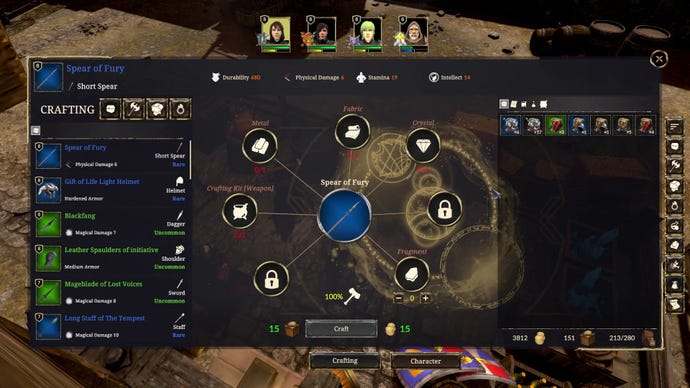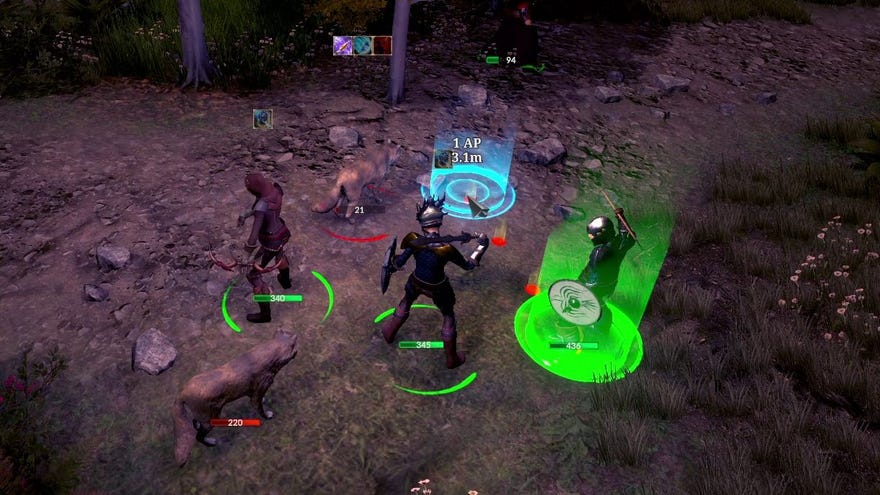Zoria: Age Of Shattering review: a systems-heavy RPG that punches above its weight
In peril? My fantasy kingdom?
Zoria: Age Of Shattering speedruns its fantasy RPG origin story in a quick cutscene montage at the start, so we might as well get that out of the way first, too. Low fantasy world, two warring kingdoms, one uses necromancy (this is cast as bad and cheating rather than practical, for some reason) to comprehensively gain the upper hand, and everything is named like a bunch of Scrabble letters were thrown randomly on the table. You play Elion war hero Captain Witherel - gender and class TBD by the player - in a small group making a final stand at the fortress Daeg Marastir, which is being overrun by the nefarious Izirian army. We start in media bellum, as it were.
This first stage, where you escape the fortress, gives you a whistle-stop tour of the main systems in the game. You control a squad of four, the combat is turn-based, you can pitch camp at any time to rest and heal up, and there are crafting systems for potions, food and gear. Zoria isn't really remaking the wheel as much as it is taking spokes from a bunch of other fantasy RPGs you like, and the result is the terrier of RPGs. Small, clearly has a lot of different DNA knocking around in there, and punches above its weight, but it's a bit scrappy and sometimes it's knees dislocate and it falls over. This terrier was made by three people, so that is sort of to be expected.
But boy, does it have spirit. You're assigned to a sort of secret fortress near a mountain pass to prepare a retaliation. This fortress can be upgraded to confer bonuses or different potential squadmates, and any squaddies you aren't using - more of them turn up, with alarming regularity, to add to your crew - can be sent on missions to get resources and that. There's a good spread of class options, including magic users like Necromancers and Priests, a Thief for your rogue type, Hunters for a bow-wielding ranger, and more martial characters like a Lancer or Kingsman. I was a Sentinel, which is a tankier character with big area buffs that help the whole party.
There are loads of little knock on effects with your squad. If you have a Battle Cleric in your party you can use the healing shrines out in the world, meaning you can heal without having to rest, and classes confer bonuses during resting time that are useful too, like stopping bleeding or healing curses. This is cool. It extends to some side quest dungeons, which need a particular character type to get through an obstacle - a Kingsman to repair a big geared door, for example. But the dungeons don't tell you this before hand, and to change your squad makeup you have to haul ass all the way back to your fortress - and then the dungeons aren't marked with "need a Kingsman!" afterwards, so in most cases I just forgot and couldn't be arsed finishing those quests off.

This is later in the game, when the difficulty starts ramping up again, but the opening was honestly balanced to be so difficult that if I hadn't been reviewing it I would have walked away from Zoria. You have to push through (also all fights make the screen go a bit greyscale, so sorry about the screenshots).Image credit: Rock Paper Shotgun/Anshar Publishing
Similarly crafting, though billed as an important part of Zoria necessary for getting decent gear, is fiddly, complicated, and confers few tangible rewards. Some of the key ingredients you use are hard to come by and not really explained, so I likewise didn't really bother crafting much at all, instead relying on gear I picked up from slaughtering goblins and ogres and suchlike. The Alchemy and Cooking systems, though, are easier to figure out - you make potions, and meals give you Breath Of The Wild-esque limited time buffs - and can be done whenever you rest at camp.
Resting is something you can do anytime, anywhere, and its main purpose is regaining health, but here, too, are interesting interactions. As well as the class bonuses available, and the food, you need to have enough supplies to actually rest (2 per squaddie per hour), so you have to keep an eye on how many you have before you go off adventuring. Resting also reduces your Focus, which is the all-purpose ability juice used by all characters to cast spells or use skills in battle. Sometimes it's better to go into a fight with your Necromancer on full Focus so he can cast a huge AOE curse. It strikes a good tactical balance, and one that becomes more acute as you get into the difficult areas of the game.
This is really all in service to Zoria's combat, which is both good and bad. Like many turn-based combat systems, you've got your Action Points to use on moving, attacking, or using an ability. It's satisfying to get a cascade of good turns: using your Priest to stun an enemy archer, while your Necromancer casts a damage-over-time pestilence on the tank, but your Lancer buffed everyone's shield first so you can afford to keep both your spellcasters in a slightly more dangerous position. But Zoria also gestures towards systems that feel like they should be there, but aren't. You can find alternate routes into fights that might put you in a better position, but you can't actually do a surprise attack. Putting your archer or spellcasters in good positions is essential, but there aren't any different elevations or, like, half cover, or the ability to move one character indvidually to do a pincer attack, so you basically just play every fight in a 2-2 formation like a football team of fantasy LARPers.


This is not aided by some jank, which means sometimes enemies can target you through huge lumps of set dressing rock, fights in buildings with cutaway walls feature walls that do not, in fact, cut away, and sometimes quest markers will just disappear entirely, mere shadows on the wall of a cave. You will spam quicksave, but for the most part combat is enjoyable enough, especially if you've beefed up some DPS characters.
You may wonder why I have completely abandoned talking about the plot or setting, and that is because it really takes a background to the systems. This is a clicky, systems-heavy RPG. You will not be shagging any elves, and it's all isometric anyway so I'm not sure what benefit you'd get out of it. None of your potential squadmates have stories or personalities, and most have a duplicate back at base anyway, so there aren't really any emotional stakes in play on a micro level fight to fight, or really on a macro level with the saving the world business.
You won't find a best mate in Zoria's sidequests either. They're of the eliminate some bandits, help out the local village variety, but really whatever the framing of the mission is (missing daughter; lot of skeletons) the outcome will be going to a dungeon and fighting a few waves of lower level enemies (small spiders; nefarious Izirians) before taking on an elite boss (big talking spider queen; huge Izarian necromancer). The setting in which you do this is very nicely outfitted, with medium-ish maps full of plants and ruined buildings and weird crystals for set dressing, and a day/night cycle. The most compelling storytelling is, rather than line-to-line dialogue, in the larger plot point as you discover the Izirians are using unknown, part-magic technologies to teleport past your defences. It's intriguing, lore-lite stuff that swiftly becomes lore-heavy when dialogue and explainers are piled on top.
Zoria is doing a lot of stuff. It'll remind you of Baldur's Gate, Dragon Age, Lord Of The Rings, even Terry Brooks' weird fantasy books, and a bunch of it is done well, and in interesting ways. But in other cases the ambition has stretched beyond breaking point. But you kind of love your terrier even though it pisses on your cushions sometimes, right?
This review is based on a retail build of the game, provided by developers Tiny Trinket Games.









